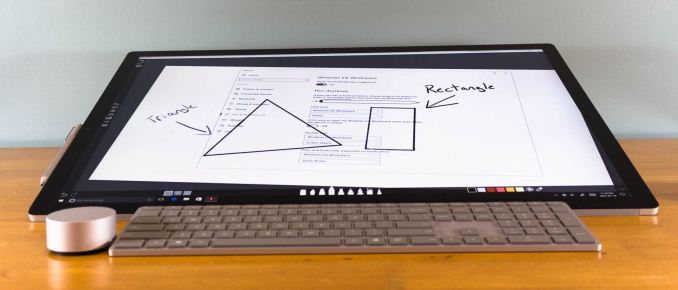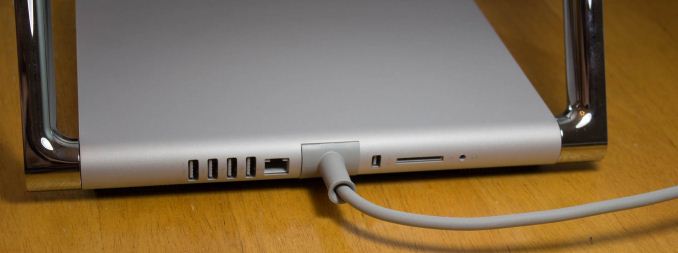The Microsoft Surface Studio Review
by Brett Howse on January 20, 2017 8:00 AM EST- Posted in
- Desktop
- Microsoft
- Surface
- Surface Studio
Design and the Zero-Gravity Hinge
Microsoft has built a brand around Surface, and that’s not an easy thing to accomplish. The Surface Studio fits in very well with the design ethos of the rest of the Surface lineup, and there has been quite a bit of attention to details paid in the creation of their first desktop computer. The first, and most obvious, is the finish, which matches perfectly with the other Surface devices, despite being made from aluminum rather than the magnesium alloy used on the portable products.
The 3:2 aspect ratio of the Surface Studio display is now a hallmark of the Surface brand (outside of Surface Hub), and having a taller display makes doing most tasks on a desktop a more pleasant experience. The increased surface area can’t be forgotten either, with the Surface Studio offering 17% more screen real estate than what's arguably the Studio's closest competitor, the 27-inch iMac, which amounts to an additional 54 square inches of display. Widescreen at 16:9 has never been a great aspect ratio for PC tasks, but the proliferation of high definition television seems to have moved the entire industry this way in an effort to save costs. When looking at the price of the Surface Studio, it’s important to remember that the entire display industry has moved to 16:9 as a standard, which impacts the entire supply chain and tooling required. Moving to an aspect ratio outside of 16:9 has large cost implications, but the end results are certainly worth it. Hopefully we will see a few other manufacturers use this as a means to source displays like this, much like the Surface Pro 3 and Pro 4 have ushered in more 3:2 devices at that much smaller size. And speaking of attention to detail, the Surface Studio is actually 28.125-inches diagonal, and as we'll see in a bit, that last 0.125-inches is very important.
It seems with Surface, Microsoft always wants to have a trick up their sleeve. With the original Surface RT and Surface Pro, it was the kickstand, which has been adopted by quite a few manufacturers for their own device since it works so well. When they launched their first laptop, the Surface Book, it was the muscle wire locking mechanism to remove the display from the base, as well as the dynamic fulcrum hinge to make the top-heavy laptop more stable. With the Surface Studio, the zero-gravity hinge is most definitely its signature design feature.
With two chrome arms flanking the base, the Surface Studio can almost effortlessly be folded down into a drafting table. The hinge mechanism provides a perfect counterbalance to the weight of the display, making it feel like it has almost no weight at all. The hinge is a single movement as well, so you don’t tip and fold the screen, but instead folding the screen also causes it to move down. While this does limit the functionality somewhat – for instance, you can't move the screen half way down and then fold it up straight again – the result is truly a wonderful design which almost needs to be seen in person.
Because you can’t tip the screen without folding it, once you stop at any angle, the screen is very solid to work with, although it is the most secure when folded all the way down to the 20° angle. You would think a large desktop display would not be ideal to use with touch, but the Surface Studio zero-gravity hinge invites you to be more interactive with it, by keeping the display close and folding it down when needed. More traditional all-in-one computers with a touch screen are nowhere near as easy to work with, since holding your arm in dead-air can be tiring, but the folded display doesn’t suffer from these burdens.
The PC base also exudes Surface quality, with the signature color, and cooling vents all the way around in the same fashion as the Surface Pro and Surface Book. The PC base can be disassembled from the bottom if required, for access to the storage and fans, but the remainder of the system is soldered to the board as you would expect in a small form factor device like this. The most frustrating part of the Surface Studio base is that all the inputs and outputs are on the rear of the device, so connecting something over USB, or inserting a SD card into the PC, is not as simple as it should be. This is a form over function decision, and it would be nice to see some of the ports offered at least on the side of the base to make it a bit easier to access.
The desktop PC market has not been as exciting to watch as the smaller and more portable laptops and tablets, but the Surface Studio sets a new high mark for desktop PC design and looks. Some of the decisions are form over function, but the majority of the design decisions actually improve the user experience. The zero-gravity hinge is a masterpiece of engineering, with such a smooth action that it really does feel like the display has no mass at all.













197 Comments
View All Comments
Valantar - Saturday, January 21, 2017 - link
"The most frustrating part of the Surface Studio base is that all the inputs and outputs are on the rear of the device, so connecting something over USB, or inserting a SD card into the PC, is not as simple as it should be. This is a form over function decision, and it would be nice to see some of the ports offered at least on the side of the base to make it a bit easier to access."Not quite form over function - the hinge mechanism and 20 degree angle would interfere with ports on all three sides (the hinges fold flat along the sides, and the display either touches the front or comes very, very close when folded all the way down. Cables, SD cards and the like sticking out would make this a hassle, and essentially break the functionality that is the core of this computer.
Brett Howse - Saturday, January 21, 2017 - link
Yes, it wouldn't work in the current design perfectly (although the SD card could easily be at the front) but regardless, having all of the ports on the rear makes it a chore to access them.Manch - Monday, January 23, 2017 - link
I saw that and thought a break out box would be nice. Of course that would make it less tidy, but having a bunch of cables run from around the backside worse.alkonaut - Saturday, January 21, 2017 - link
Is the motherboard and other hardware in the base, separate from the screen, meaning it could (at least in theory) be replaced while keeping the display?A display this good/expensive *has* to last at least 3 computers - so a definite no-go if it has to follow the motherboard/cpu/ram/ssd to the trash in 3 years!
Brett Howse - Saturday, January 21, 2017 - link
In theory, but unlikely this would ever be practicalManch - Monday, January 23, 2017 - link
I think we will see this with an upgraded base ala Surface Book. I doubt it will ever be user upgradeable which would be a nice. I don't know why people insist this will be in the trash in 3 years. Give it to me! If intels progress is any indication, you CPU will be good for a loooong time. Also for what this is designed for, I just don't see the applications out running the hardware anytime soon. With the Creators Update not out for a bit, I think they had enough time and should have went 1060/107 at least for the high end. Overall, a lust worthy machine. I don't need one, but damn I wouldn't mind having one.mobutu - Sunday, January 22, 2017 - link
I applaud the company for this obsessive attention to detail but what in the hell were they thinking fitting oldtech inside? thats just crazy and goes on the opposite spectrum of that obsessive attention to detail!-new cpu
-new gpu (lol, easily the BIGGEST mistake)
-ssd pcienvme only (I take a piss on their hybrid crap)
-in 2017, any computer should be dead silent while doing light workloads (browse, email etc). WTF they were thinking, designing this device with artists/creators in mind and giving them a noisy computer when they need SILENCE to be able to create properly!!!
-still big bezels on the otherwise wonderful display.
And LOL, ETA 6months for a GTX980??? thats gotta be a joke or something, when your "new" pc is arriving, that maxell is gonna be very ancient tech already, not just old!
As usual, wait for the next wave when they'll learn their lesson. Buying this now is kinda stupid.
mobutu - Sunday, January 22, 2017 - link
also, forgot about no usbc thinderbolt hdmi dp ... so connectivity also suffers in the curent implementationfanofanand - Monday, January 23, 2017 - link
Artists don't have a clue about anything you just wrote. They will just see the price tag and think "man this thing must be good" and will buy it. Do you really think the average artist knows the difference between a 965, a 980, and a 1080?nerd1 - Sunday, January 22, 2017 - link
So.. monitor is AWESOME and other parts are worse than $1500 laptop. Why doesn't they sell the monitor+touchscreen as a separate USB-C device, i.e. for $1500? I'd get one ASAP!